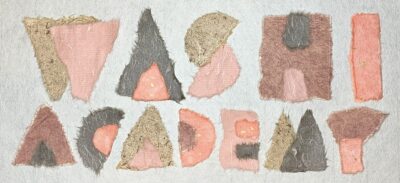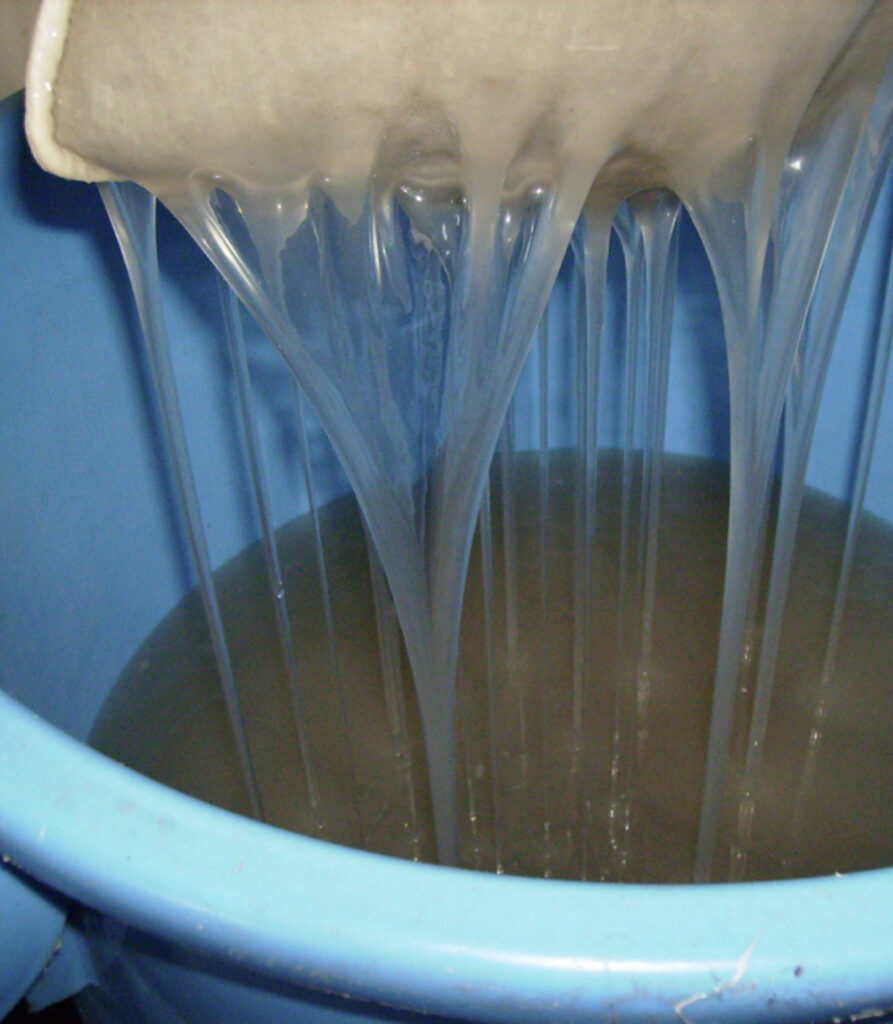Together with the prepared bast fibres (kozo, mitsumata, and gampi), and sufficient cold, clean water, the third essential ingredient in the Japanese papermaking process is neri. Neri is a mucilaginous liquid derived from plants (usually tororo-aoi—see part 2 for a detailed description) that is added to the papermaking vat. Adding neri slows the drainage of the pulp solution through the screen (su) of the papermaking tool (among other effects) and allows the papermaker to more easily form sheets of even thickness. Neri is often referred to in English as a “formation aid.” This post (part 1) explains what neri is and why it is essential to the washi papermaking process. Part 2 talks about the common misunderstandings related to neri, and explains how to prepare and use it.
Papermakers in Japan have made use of neri for many centuries. By looking at the formation quality of historical paper samples, washi scholars have ascertained that the adoption of neri occurred at some time during the Heian period (794–1195 A.D.). The papers during that epoch become more even in thickness, with a much cleaner formation quality. Many experts speculate that the adoption of neri came after papermakers discovered that making paper with gampi fibre, which has its own mucilaginous quality, allowed them more time to manipulate the pulp solution back and forth across the surface of the papermaking screen (the su), resulting in stronger, more even sheets of paper. It’s speculated that this revelation encouraged papermakers to seek out another source for mucilage to add to the papermaking vat for use with kozo and other fibres that lack mucilaginous qualities of their own. Whether neri is a Japanese discovery or an innovation that entered Japan through (most likely) China or Korea is still being debated. Historically, papermakers in different regions of Japan referred to the gooey material by different names, including nebeshi, tamo, sana, nire, and most prominently nori (more about nori in part 2). The term neri comes from the papermaking region of Echizen and it seems that use of this word has now spread throughout Japan to the point of being nearly universal1, due in part to Echizen’s prominence as a papermaking region.
Neri has a complex role in the sheet-forming process, but stated simply, neri has three unique and inter-related characteristics that make it essential to the washi papermaking process. First, as mentioned above, it works to slow the drainage of the pulp solution from the sugeta (papermaking tool), allowing the craftsperson time to manipulate the solution back and forth across the surface of the su. Second, it encapsulates the individual pulp fibres to distribute the fibre evenly in the vat. Third, it more or less disappears when the papermaking process is complete. Think of these characteristics as the Three Ds:
DRAINAGE—The most critical function of neri is to slow the drainage of the pulp solution through the su. If a pulp solution without neri is scooped into the sugeta, the water will immediately drain through the su, leaving a clumpy mess on the surface. When neri has been added, the drainage of the pulp solution slows dramatically. In this way, the papermaker has time to deftly rock the sugeta back and forth and from side to side, evenly distributing the fibres across the surface of the su. Stated simply, by controlling the amount of neri in the vat, and thus the drainage rate on the screen, the papermaker can more easily dictate the thickness and quality of the paper.
DISPERSION—The second function of neri is to encapsulate each individual fibre, allowing the papermaker to uniformly distribute the fibre in the vat of water, and retarding the fibres’ natural tendency to sink in the vat. Scientifically speaking, the neri carries a negative charge, and after encapsulating each fibre, it works to repel the fibres from each other, which prevents flocculation (clumping) of fibres. This even dispersal leads to sheets of even thickness, but it also allows for stronger and greater chemical bonds, which makes for stronger paper. Japanese papermakers talk about a number of highly sought after characteristics in finished sheets of washi. These include “koshi ga aru” (a kind of firmness), a compacted and less porous sheet surface, and a surface lustre, all of which come at least in part from stronger and greater bonds, which in turn are a result of even dispersion.
DISAPPEARANCE—The third special characteristic of neri is that, even though it has the power to slow the drainage, once the paper is formed, pressed, and dried, neri does not remain in the paper, except in trace amounts.2 As a result, each finished sheet of washi is simply (miraculously) a mat of uniformly dispersed and chemically bonded cellulose fibres. This disappearance may seem hard to believe, but chemical analysis of finished sheets has proven it to be true. Somehow the compound breaks down and is carried away with the water/moisture that is removed during the pressing and drying of sheets. It may be easier to understand when one considers the fact that neri made from tororo-aoi is extremely sensitive to temperature, friction, and bacteria. This is part of the reason why the best washi paper can be made in the winter season, when neri is most effective, whereas paper made in the summer, when neri is weak and quick to lose its effectiveness, is usually limp, poor quality paper. The fact that neri weakens and eventually disappears—and that the papermaker must constantly adjust for that variability—is part of what makes sheet-forming so difficult, but it is also the reason neri can safely be used in the process at all.

